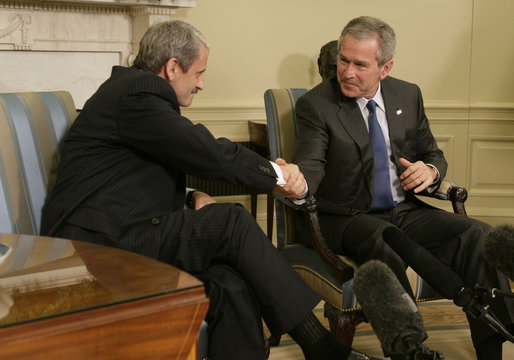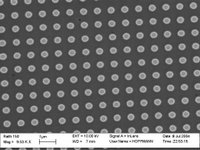President Welcomes Prime Minister of Slovakia to the White House The Oval Office, FULL STREAMING VIDEO, In Focus: Global Diplomacy 10:35 A.M. EST
to helping the young democracies in Afghanistan and Iraq succeed. White House photo by Paul Morse.THE PRESIDENT: Mr. Prime Minister, welcome. Thank you for coming. I always enjoy being with you because you're an optimistic, upbeat believer in the people of your country and the possibilities to work together to achieve peace. And so thanks for coming.
I admire the job you have done, and I admire the record that you have produced. A lot of times in politics, people are pretty good talkers, but they don't follow through. You have followed through.
We discussed a lot of issues. I thank the Prime Minister for his contributions to helping young democracies succeed, democracies in Afghanistan and Iraq. And I want to thank you for that.
We discussed the importance for transatlantic ties between the United States and not only Slovakia, but also between the United States and Europe. And I assured him that those transatlantic ties are an important part of our policies here.
We talked about two issues that I found -- that I know are important. One, of course, is the visa issue. The Prime Minister made it very clear that he expects there to be some progress on the visa issue, that he's -- he represents the good people of Slovakia when he says to me that there needs to be a constant renewal of the process to make sure that it is fair. And I appreciate -- I listened very carefully to my friend and can assure the people of Slovakia that we are working together to make the visa policy work better.
Secondly, he talked about the knowledge-based economy that he envisioned for his country. And I thought, first of all, it's very wise to -- he recognizes the world and the challenges of the world and knows full well that as people gain knowledge, a country is going to end up being more competitive in the 21st century.
And so I -- we strategized about ways to help Slovakia and the United States benefit from exchanges, and particularly student exchanges, so that knowledge becomes a paramount part of our future.
And so Mr. Prime Minister, thanks for your vision. And I also feel sorry for the fact that you broke your leg. This guy's a good runner. And so now I feel comfortable challenging you to a race. (Laughter.) Had you been healthy, I wouldn't even had gotten on the same track with you. But I wish you a speedy recovery, and thanks again for coming to the United States.
PRIME MINISTER DZURINDA: Thank you, Mr. President. My leg is broken, but my heart is happy. (Laughter.) My heart is happy because we are friends and strong allies, America and Slovakia, America and the European Union. I am happy being here because we are good friends. President Bush visited us a year ago, he visited President of Russia, Mr. Putin, in Bratislava, and we remember this fantastic stay of President Bush in Slovakia.
We are good friends, and we share the responsibility for development in the world. I highly appreciate the leadership of President Bush in solving of global issues, the most hot and most complicated issues in the world. And I talked to President Bush that transatlantic cooperation is and must stay the basis of our security. This is something like axis of stability, prosperity and the future of both countries. But also, the future of the democratic world.
As President Bush has already mentioned, we have some bilateral issues. I appreciate especially his State of the Union, during which he announced a new program how to educate people, young generation. We want to do the same. We want to find a new way, thanks to which it would be possible to cooperate with the United States also in the area of science research, and development, innovation, education. And I believe that we will discover these new ways.
Of course we spoke many issues of foreign policy, as usually. And I can only tell that our view is the same and we will continue in this cooperation to advance freedom and democracy in the world. Mr. President, thank you very, very much for being such a good leader.
PRESIDENT BUSH: Thank you, sir.
END 10:40 A.M. EST, For Immediate Release, Office of the Press Secretary, March 13, 2006
Technorati Tags: President Bush and White House or Prime Minister of Slovakia and PRIME MINISTER DZURINDA or Bratislava and Europe
RELATED: Keyword, Slovakia, Thursday, February 24, 2005 President Addresses Citizens of Slovakia,












